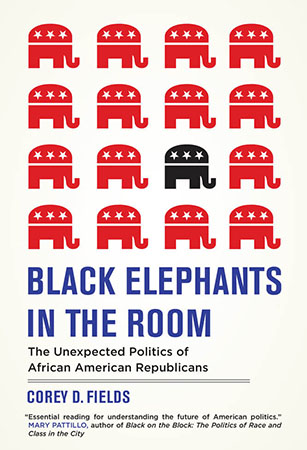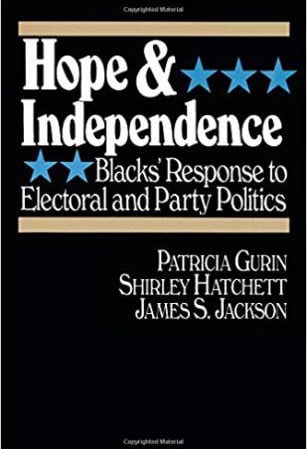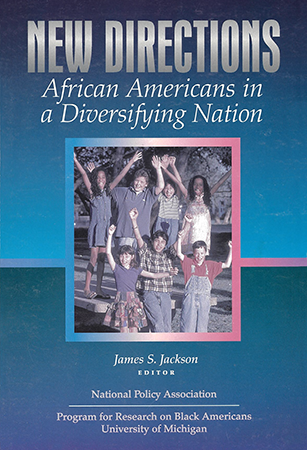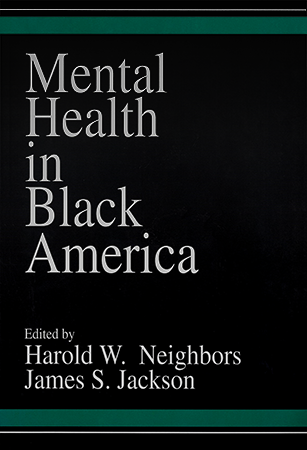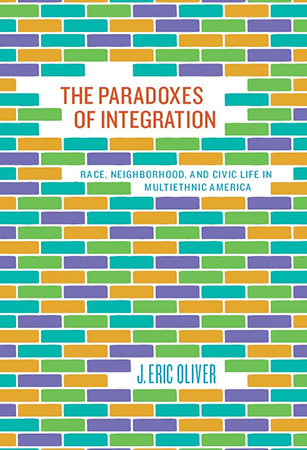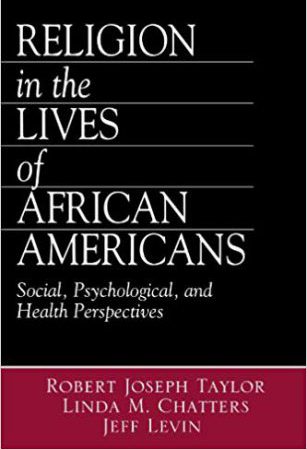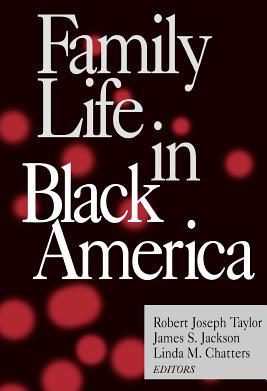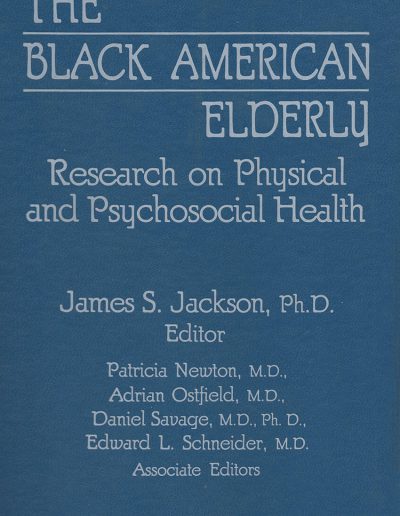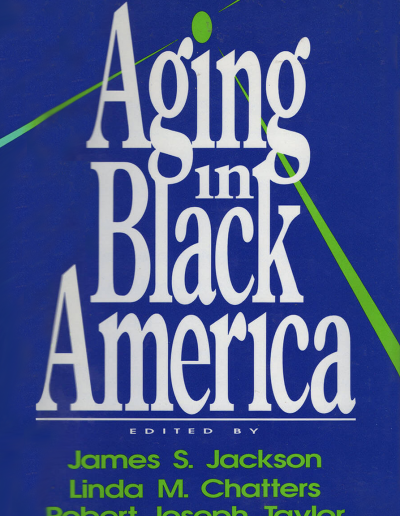Books
Black Elephants in the Room: The Unexpected Politics of African American Republicans
Fields, C.D. (2016). University of California Press.
Hope and Independence: Blacks’ Response to Electoral and Party Politics
Gurin, P., Hatchett, S. J., & Jackson, J. S. (1989). Russell Sage Foundation.
New Directions: African Americans in a Diversifying Nation
Edited by James S. Jackson. (2000). National Policy Association.
Mental Health in Black America
Edited by Harold W. Neighbors and James S. Jackson. (1996). Sage Publications.
The Paradoxes of Integration: Race, Neighborhood, and Civic Life in Multiethnic America
Oliver, J. E. (2010). University of Chicago Press.
Religion in the Lives of African Americans: Social, Psychological, and Health Perspectives
Taylor, R. J., Chatters, L. M., & Levin, J. (2004). Sage Publications.
Family life in Black America
Edited by Robert Joseph Taylor, James S. Jackson, and Linda M. Chatters. (1997). Sage Publications.
Fields, C.D. (2016). Black Elephants in the Room: The Unexpected Politics of African American Republicans. Oakland, CA: University of California Press.
“Black Elephants in the Room considers how race structures the political behavior of African American Republicans and discusses the dynamic relationship between race and political behavior in the purported “post-racial” context of US politics. Drawing on vivid first-person accounts, the book sheds light on the different ways black identity structures African Americans’ membership in the Republican Party. Moving past rhetoric and politics, we begin to see the everyday people working to reconcile their commitment to black identity with their belief in Republican principles. And at the end, we learn the importance of understanding both the meanings African Americans attach to racial identity and the political contexts in which those meanings are developed and expressed.”
Table of Contents
Introduction
From Many to Few
Beyond Uncle Tom
Race Doesn’t Matter
Black Power through Conservative Principles
Whither the Republican Party
Conclusion
Gurin, P., Hatchett, S. J., & Jackson, J. S. (1989). Hope and Independence: Blacks’ Response to Electoral and Party Politics. New York: Russell Sage Foundation.
Black Participation in American political life has been a recurrent subject of analysis and scholarship. Its import increased manifold when the 1965 Voting Rights Act began to loosen the political chains that had bound southern blacks ever since the 1890s. By the 1970s, scholars had begun to talk of a New Black Politics that fused protest and electoral forms and had a strong base in organizations spawned by the Civil Rights and Black Power movements of the 1960s. The 1984 election offered a special opportunity to shed light on a long history of black politics by going directly to black Americans in a broad-scale national survey.
Table of Contents
Blacks and Electoral and Party Politics: A Historical Overview
The Political Motivation and Resources of the Black Electorate
Separate Themes: Support for Jesse Jackson and Advocacy of a Black Political Voice
Supporters of Jesse Jackson: Their Solidarity and Their Political Outlooks
Advocates of a Black Political Voice: The Powerless Seeking to be Heard
Social Class, Black Solidarity and Politics
Basic Themes in Black Politics
(App. A) Methodological Issues in Telephone Surveys of Black Americans:
The 1984 National Black Election Study
Jackson, J.S. (Ed.). (2000). New Directions: African Americans in a Diversifying Nation. Washington DC: National Policy Association.
Edited by James S. Jackson
Presents significant and timely data on eight topical areas as well as thought-provoking recommendations for eliminating racial disparities and promoting greater awareness of the complexities arising from America’s new diversity.
Beginning with a review of current demographic data and an analysis of public attitudes on race and other policy issues, the study addresses income and wealth, education, health, family structure, politics, and criminal justice. It finds that the increasing diversity within the African American population indicates both progress and continuing challenges in each area. The study discusses the potential of several models of intergroup collaboration and the pitfalls of competition as all sectors of society seek to obtain the benefits of America’s growing prosperity.
In the tradition of several seminal works in the past century, New Directions: African Americans in a Diversifying Nation contributes to a greater understanding of race relations in contemporary America. W.E.B. DuBois’s oft-quoted insight in his 1903 work, The Souls of Black Folk, that the problem of the 20th century would be the “color line” has indeed been proved true. In 1944, Gunnar Myrdal’s An American Dilemma: The Negro Problem and American Democracy shed powerful light on the extent of racism in American society as it approached mid-century. The National Research Council’s 1989 work, A Common Destiny: Blacks and American Society, documented the dramatic changes for African Americans in the postwar years.
Table of Contents
Foreword
Introduction – James S. Jackson
Demographic, Economic, and Social Trends in a Multicultural America – Reynolds Farley
Race Relations in a Diversifying Nation – Jennifer L. Hochschild & Reuel R. Rogers
Languishing in Inequality: Racial Disparities in Wealth and Earnings in the New Millennium – William A. Darity, Jr. & Samuel L. Myers, Jr.
Large Gains, Recent Reversals, and Continuing Ingquality in Education for African Americans – Michael T. Nettles & Gary Orfield
African Americans and Health Policy: Strategies for a Multiethnic Society – Thomas A. LaVeist
Considerations in the Development of Family Policy for African Americans – M. Belinda Tucker
An Overview of Black American Politics and Political Participation Since the Civel Rights Movement – Paula D. McClain & Joseph Stewart, Jr.
Race, Crime, and Punishment: Old Controversies and New Challenges – Darnell F. Hawkins & Cedric Herring
African American Prospects in the 21st Century: A Framework for Strategies and Policies – James S. Jackson
Jackson, J. S. (Ed.). (1991). Life in Black America. Newbury Park, CA: Sage Publications.
Edited by James S. Jackson, Ph.D.
Life in Black America presents an abundance of recent research on the social, psychological, economic, and political behaviors of Americans of African descent. Originating from the National Survey of Black Americans (NSBA), this book examines this major research project–the first study to sample a truly representative cross section of blacks in America.
Table of Contents
Foreword – Anderson J. Franklin
Introduction – James S. Jackson
Methodological Approach – James S. Jackson
Neighborhood Life – Norweeta G. Milburn & Phillip J. Bowman
Family Life – Shirley J. Hatchett, Donna L. Cochran, & James S. Jackson
Women and Men – Shirley J. Hatchett
Religious Life – Robert J. Taylor & Linda M. Chatters
Work Life – Phillip J. Bowman
Joblessness – Phillip J. Bowman
Retirement – Rose C. Gibson
Physical Health – Linda M. Chatters
Mental Health – Harold W. Neighbors
Race Identity – James S. Jackson, Wayne R. McCullough, Gerald Gurin & Clifford L. Broman
Political Action – Ronald E. Brown
The Black American Life Course – James S. Jackson
Jackson, J. S. (Ed.). (1988). The Black American Elderly: Research on Physical and Psychosocial Health. New York: Springer Publishing Co.
Edited by James S. Jackson, Ph.D.
The purpose of this book is to present current knowledge on a relatively unexamined scientific subject–the black aging process–and to explore where future research efforts should be directed. This book is a compilation of papers that were presented during a two-day workshop, “Research on Again Black Populations,” health at the National Institutes of Health on September 25 and 26, 1986. The National Institute on Aging, the American Association of Retired Persons (AARP), and the Department of Health and Human Services’ Minority Health Office served as co-sponsors.
Table of Contents
Part 1: Introduction
Growing Old in Black America: Research on Aging and Black Populations – James S. Jackson
The Role of Black Universities in Research on Aging Black Populations – David Satcher
Part 2: Demography and Epidemiology of Older Black Adults
The Demography of Older Blacks in the United States – Ron C. Manuel
Cancer Prevention and Control in the Black Populations in the United States – Claudia R. Baquet
Social Determinants of the Health of Aging Black Populations in the United States – Jacquelyne Johnson Jackson
Social Participation in Later Life: Black-White Differences – Linda K. George
Part 3: Biological and Health Status of Older Black Adults
Dietary Intake and Nutritional Status of Older U.S. Blacks: An Overview – Norge W. Jerome
Diabetes and Obesity in Elderly Black Americans – Leslie Sue Lieberman
Aging and Hypertension among Blacks: A Multidimensional Perspective – Norman B. Anderson
Dementing Illness and Black Americans – F. M. Baker
Part 4: Social and Behavioral Processes among Older Black Adults
Subjective Well-Being among Older Black Adults: Past Trends and Current Perspectives – Linda M. Chatters
Aging and Supportive Relations among Black Americans – Robert Joseph Taylor
Aging and Hypertension among Blacks: A Multidimensional Perspective – Norman B. Anderson
Health-Seeking Behavior of Elderly Black – Tyson Gibbs
Health Attitudes/Promotions: The Black Elderly – James H. Carter
The Work, Retirement, and Disability of Older Black Americans – Rose C. Gibson
Part 5: Methodological Issues in Research on Older Black Adults
Survey Research on Aging Black Populations – James S. Jackson
The Design and Conduct of Case-Control Studies in Research on Aging Black Populations – Jerome Wilson
Clinical Trials and the Black Elderly: Issues and Considerations – Bettie Nelson Knuckles and Camilla A. Brooks
Part 6: Conclusions
Future Directions in Research on Aging Black Populations – James S. Jackson
Jackson, J. S., Chatters, L. M., & Taylor, R. J. (Ed.). (1993). Aging in Black America. Newbury Park, CA: Sage Publications.
Edited by James S. Jackson, Linda M. Chatters & Robert Joseph Taylor
Reflecting the major substantive issues related to psychological and social dimensions of aging, this book offers a broad perspective on a variety of issues relating to black Americans today. Among the topics examined are community, friends, and family; church and religion; health, social functioning, and well-being; group identity and political participation; and retirement and work.
Table of Contents
Roles and Resources of the Black Elderly – James S. Jackson, Robert Joseph Taylor, & Linda M. Chatters
Section I: Community, Friends, and Family
Neighborhoods, and Neighbor Relations – Rukmalie Jayakody
Crime Stress, Self-Esteem, and Life Satisfaction – John L. McAdoo
Gender, Marital, Familial, and Friendship Roles – Robert Joseph Taylor, Verna M. Keith, & M. Belinda Tucker
Intergenerational Support: The Provision of Assistance to Parents by Adult Children – Linda M. Chatters & Robert Joseph Taylor
Intimate Partnerships – Eleanor Engram & Shirley A. Lockery
Section II: Church and Religion
Religion and Religious Observances – Robert Joseph Taylor
Function and Supportive Roles of Church and Religion – Jacqueline M. Smith
Section III: Health, Social Functioning, and Well-Being
Physical Health – Mary McKinney Edmonds
Health Disability and Its Consequences for Subjective Stress – Linda M. Chatters
Mental Health and Help-Seeking Behavior – Ruth L. Greene, James S. Jackson, & Harold W. Neighbors
Section IV: Group Identify and Political Participation
Identity and Consciousness: Group Solidarity – Robert J. Smith and Michael C. Thornton
Group Consciousness and Political Behavior – Ronald E. Brown and Rupert W. Barnes-Nacoste
Demographic and Religious Correlates of Voting Behavior – Robert Joseph Taylor and Michael C. Thornton
Section V: Retirement and Work
The Black Americans Who Keep Working – Lerita M. Coleman
The Black American Retirement Experience – Rose C. Gibson
Section VI: Life Course of African Americans
Status and Functioning of Future Cohorts of African-American Elderly: Conclusions and Speculations – James S. Jackson, Linda M. Chatters, & Robert Joseph Taylor
Neighbors, H. W., & Jackson, J. S. (Eds.). (1996). Mental Health in Black America. Thousand Oaks, CA: Sage Publications.
Edited by Harold W. Neighbors and James S. Jackson
Table of Contents
The Mental Health of Black Americans: Psychosocial Problems and Help-Seeking Behavior – Harold W. Neighbors & James S. Jackson
A Model Free Approach to the Study of Subjective Well-Being – Carolyn Benett Murray & M. Jean Peacock
Stress and Residential Well-Being – Gayle Y. Phillips
Problem Drinking, Chronic Disease, and Recent Life Events – Isidore S. Obot
An Analysis of Stress Denial – Rhoda Barge Johnson & Joan E. Crowley
Marital Status and Mental Health – Diane R. Brown
The Association Between Anger-Hostility and Hypertension – Ernest H. Johnson & Larry Gant Coping With Personal Problems – Clifford L. Broman
Kin and Non-Kin as Sources of Informal Assistance – Robert J. Taylor, Cheryl Burns Hardison, & Linda M. Chatters
Predisposing, Enabling, and Need Factors Related to Patterns of Help-Seeking Among Black Women – Cleopatra H. Caldwell
Mental Health Symptoms and Service Utilization Patterns of African American Women – Vicki Mays, Cleopatra H. Caldwell, & James S. Jackson
The Police as a Help Resource in African American Communities – Patricia A. Washington
Conclusion – James S. Jackson & Harold W. Neighbors
Oliver, J. E. (2010). The Paradoxes of Integration: Race, Neighborhood, and Civic Life in Multiethnic America. Chicago, IL: University of Chicago Press.
“The United States is rapidly changing from a country monochromatically divided between black and white into a multiethnic society. The Paradoxes of Integration helps us to understand America’s racial future by revealing the complex relationships among place, community, and racial attitudes among Asian Americans, Blacks, Latinos, and Whites.”
Table of Contents
Introduction: Place and the Future of American Race Relations
Why Place Is So Important for Race
Racial Attitudes among Whites, Blacks, Latinos, and Asian Americans
Neighborhood- and Metropolitan-Level Differences in Racial Attitudes
Geographic Self-Sorting and Racial Attitudes
Interracial Civic and Social Contact in Multiethnic America
The Civic and Social Paradoxes of Neighborhood Racial Integration
On Segregation and Multiculturalism
Taylor, R. J., Chatters, L. M., & Levin, J. (2004). Religion in the Lives of African Americans: Social, Psychological, and Health Perspectives. Thousand Oaks, CA: Sage.
The religious faith of African Americans has many avenues of expression. Consequently, there has been a long-standing interest in the nature, patterns, and functions of religion in the lives of this particular ethnic group. African American religious life, in all its forms, is a vibrant, creative, resourceful testament to the power of faith to uplift and sustain in the face of prejudice, discrimination, and exclusion.
Religion in the Lives of African Americans: Social, Psychological, and Health Perspectives examines many broad issues including the structure and sociodemographic patterns of religious involvement; the relationship between religion and physical and mental health and well-being; the impact of church support and the use of ministers for personal issues; and the role of religion within specific subgroups of the African American population such as women and the elderly. Authors Robert Joseph Taylor, Linda M. Chatters, and Jeff Levin reflect upon current empirical research and derive conclusions from several wide-ranging national surveys, as well as a focus group study of religion and coping.
Table of Contents
Foreword – James S. Jackson
Introduction
African American Religious Participation
The Frequency and Importance of Prayer
Prayer as a Source of Coping
Use of Ministers for Personal Problems
Church Members as a Source of Social Support
Negative Interaction Among Church Members
Impact of Religion on Physical Health
Impact of Religion on Mental Health and Well-Being
Coclusions and Implications
Taylor, R. J., Jackson, J. S., & Chatters, L. M. (1997). Family life in Black America. Sage Press: Thousand Oaks, CA: Sage Press.
Edited by Robert Joseph Taylor, James S. Jackson, and Linda M. Chatters
Over the past 20 years, African American families have undergone tremendous changes, both demographically and socially. During this time, most of the studies of Black families have focused on problems, such as out-of-wedlock births, single-parent families, and childhood poverty. While an accurate appreciation of the challenges confronting Black families is important and needed, a “problem focus” tends to offer a narrow, negative view and restricts the consideration of other important issues affecting families. Family Life in Black America moves away from this deficit perspective and the result is enlightening both in its comprehensive reach and systematic scholarship. Readers of this volume will be pleased with the wide range of issues dealt with in this volume, including maturation, mate selection, sexuality, procreation, infancy, adulthood, adolescence, gender issues, young adulthood, cohabitation, parenting, grandparenting, and aging. Each article is firmly grounded in empirical data, based on, but not limited to, the National Survey of Black Americans (NSBA). A fresh aspect of this book is the amount of diversity it reveals within African American families and the forces that shape, limit, and enhance them
Both uplifting and informative, Family Life in Black America is truly unique in its field and will be used by professionals and students in ethnic studies, family studies, social work, psychology, research methods, and gerontology.
Table of Contents
Foreword – Andrew Billingsley
Introduction – Robert Joseph Taylor, Linda M. Chatters, & James S. Jackson
Recent Demographic Trends in African American Family Structure – Robert Joseph Taylor, M. Belinda Tucker, Linda M. Chatters & Rukmalie Jayakody
The Effects of Mate Availability on Marriage Among Black Americans: A Contextual Analysis –
K. Jill Kiecolt & Mark A. Fossett
Gender, Age and Marital Status as Related to Romantic Involvement Among African American Singles – M. Belinda Tucker & Robert Joseph Taylor
Life Stress and Psychological Well-Being Among Married and Unmarried Blacks – Verna M. Keith
Religious Involvement and the Subjective Quality of Family Life Among African Americans – Christopher G. Ellison
Multiple Familial-Worker Role Strain and Psychological Well-Being: Moderating Effects of Coping Resources Among Black Americans Parents – Ruby L . Beale
Informal Ties and Employment Among Black Americans – Robert Joseph Taylor & Sherrill L. Sellers
Families, Unemployment and Well-Being – Clifford L. Broman
Differences Among African American Single Mothers: Marital Status, Living Arrangements, and Family Support – Rukmalie Jayakody & Linda M. Chatters
Childrearing, Social Support and Perceptions of Parental Competence Among African American Mothers – Cleopatra Howard Caldwell & Lilah Koski
Strategies of Racial Socialization Among Black Parents: Mainstream, Minority & Cultural Messages – Michael C. Thornton
Instrumental and Expressive Family Roles Among African American Fathers – Phillip J. Bowman & Tyrone A. Forman
Family Roles and Family Satisfaction Among Black Men – Robert Joseph Taylor & Waldo E. Johnson, Jr.
Living Arrangements of African-American Adults: Variations by Age, Gender, and Family Status – Andrea G. Hunter
Husbands, Wives, Family and Friends: Sources of Stress, Sources of Support – H. W. Neighbors
Changes Over Time in Support Network Involvement Among Black Americans – Robert Joseph Taylor, James S. Jackson & Linda M. Chatters

